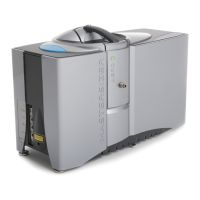Maintenanc e
92
over the circular window seal section (B).
l The section of the seal with the flat seal face must be located fully into the
seal cavity, edge to edge
10. Remove any lubricant, as described below
Repeat the above procedure when replacing the cell seal/window assembly into
the main body of the cell.
Removing Soluble Lubricant
If you are using a water soluble lubricant, such as KY Jelly, you can wash away the lub-
ricant with a wash-bottle of Deionised Water. Gently stroke the outside of the lubricated
junction with a cotton bud when washed with water.
l
If you are using water as a dispersant you can reassemble the cell and proceed
to make measurements.
l
If you are using a dispersant that is immiscible with water then you should
wash away the water with ethanol or IPA and then dry the cell. You can gently
warm the cell and blow clean air at it to increase evaporation. Mop up any
droplets of alcohol on the metalwork with an absorbent lens tissue. Place the cell
on edge, so the alcohol collects at the edge of the window. Touch the corner of
an absorbent lens tissue to any droplets of alcohol that collect at the edge of the
window to speed up the drying and limit any marks.
l
If you have used a temperature-sensitive dispersant you may have to allow the
cell to settle back to the ambient temperature before making measurements.

